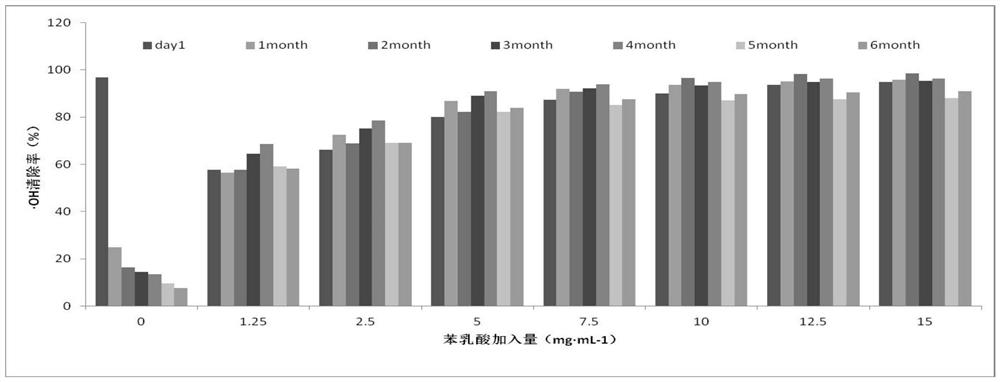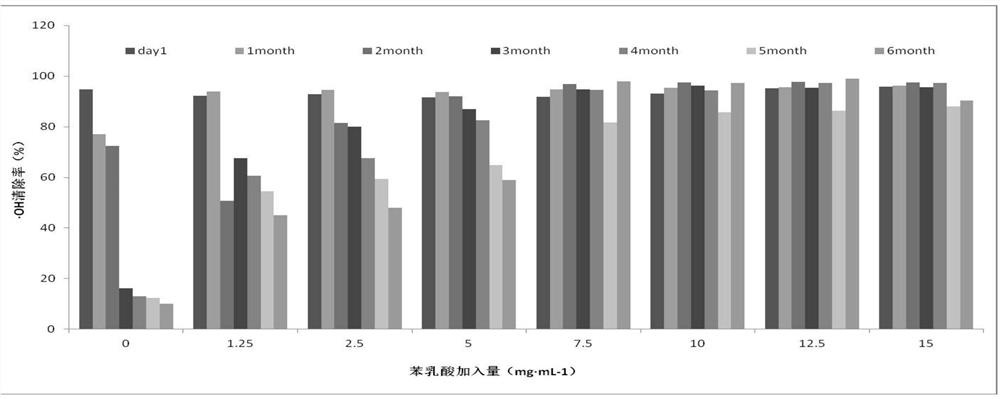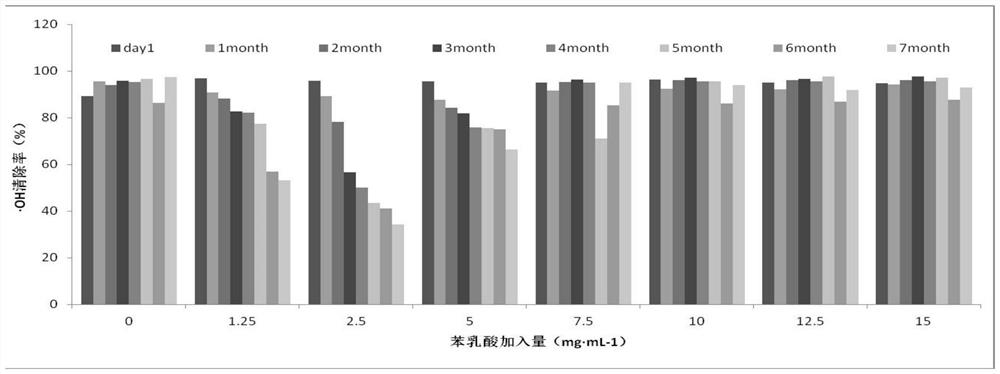A method for improving the stability of vine wound sap
A technology for wounding sap and vines, which is applied in the field of improving the stability of vine wounding sap, which can solve the problems of poor stability of vine wounding sap, research on antioxidant activity, and reduction of antioxidant activity, so as to maintain antioxidant activity , the method is simple, and the effect of improving metamorphism
- Summary
- Abstract
- Description
- Claims
- Application Information
AI Technical Summary
Problems solved by technology
Method used
Image
Examples
Embodiment 1
[0026] At room temperature, take 30mL of Kashimunage grape vine wound liquid stock solution, filter to remove insoluble impurities, including branches, residual leaves, etc., add 225mg of phenyllactic acid, and mix well.
[0027] After 64 days, the content of each component in the wound fluid was as follows: the polysaccharide concentration was 4.21 μg·mL -1 , the protein concentration is 0.09mg·mL -1 , the saponin concentration was 0.98 μg·mL -1 , the polyphenol concentration was 0.88 μg·mL -1 , the time to produce precipitation is 40 days. (In the raw solution of untreated wound fluid: the polysaccharide concentration was 12.93 μg·mL -1 , the protein concentration is 0.22mg·mL -1 , the saponin concentration was 1.59 μg·m L -1 , the concentration of polyphenols was 2.93 μg·m L -1 , the time to produce precipitation is 4 days)
[0028] A method for improving the stability of grape vine wound effusion described in the embodiment of the present invention is simple. Add ph...
Embodiment 2
[0030] At room temperature, take 30mL of Kashimunage grape vine wound liquid stock solution, filter to remove insoluble impurities, including branches, residual leaves, etc., add 300mg of phenyllactic acid, and mix well.
[0031] After 64 days, the content of each component in the wound fluid was: polysaccharide concentration was 6.55 μg·mL -1 , the protein concentration is 0.12mg·mL -1 , the saponin concentration was 1.25 μg·mL -1 , the polyphenol concentration was 1.95 μg·mL -1 , the time to produce precipitation is 40 days. (In the raw solution of untreated wound fluid: the polysaccharide concentration was 12.93 μg·mL -1 , the protein concentration is 0.22mg·mL -1 , the saponin concentration was 1.59 μg·mL -1 , the polyphenol concentration was 2.93 μg·mL -1 , the time to produce precipitation is 4 days)
[0032] A method for improving the stability of grape vine wound effusion described in the embodiment of the present invention is simple. Add phenyllactic acid to gr...
Embodiment 3
[0034] At room temperature, take 30mL of Kashimunage grape vine wound liquid stock solution, filter to remove insoluble impurities, including branches, residual leaves, etc., add 375mg of phenyllactic acid, and mix well.
[0035] After 64 days, the content of each component in the wound fluid was as follows: the polysaccharide concentration was 8.95 μg·mL -1 , the protein concentration is 0.15mg·mL -1 , the saponin concentration was 1.29 μg·mL -1 , the concentration of polyphenols was 2.31 μg·mL -1 , the time to produce precipitation is 64 days. (In the raw solution of untreated wound fluid: the polysaccharide concentration was 12.93 μg·mL -1 , the protein concentration is 0.22mg·mL -1 , the saponin concentration was 1.59 μg·mL -1 , the polyphenol concentration was 2.93 μg·mL -1 , the time to produce precipitation is 4 days)
[0036] A method for improving the stability of grape vine wound effusion described in the embodiment of the present invention is simple. Add phen...
PUM
 Login to View More
Login to View More Abstract
Description
Claims
Application Information
 Login to View More
Login to View More - R&D
- Intellectual Property
- Life Sciences
- Materials
- Tech Scout
- Unparalleled Data Quality
- Higher Quality Content
- 60% Fewer Hallucinations
Browse by: Latest US Patents, China's latest patents, Technical Efficacy Thesaurus, Application Domain, Technology Topic, Popular Technical Reports.
© 2025 PatSnap. All rights reserved.Legal|Privacy policy|Modern Slavery Act Transparency Statement|Sitemap|About US| Contact US: help@patsnap.com



